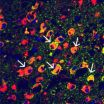(Press-News.org) Viruses often spread through the brain in patchwork patterns, infecting some cells but missing others. New research at Washington University School of Medicine in St. Louis helps explain why. The scientists showed that natural immune defenses that resist viral infection are turned on in some brain cells but switched off in others.
"The cells that a pathogen infects can be a major determinant of the seriousness of brain infections," says senior author Michael Diamond, MD, PhD, professor of medicine. "To understand the basis of disease, it is important to understand which brain regions are more susceptible and why."
While some brain infections are caused by bacteria, fungi or parasites, often the cause is a virus, such as West Nile virus, herpesvirus or enteroviruses.
For their study, now available online in Nature Medicine, the researchers focused on granule cell neurons, a cell type that rarely becomes infected. They compared gene profiles in granule cells from the cerebellum with the activity in cortical neurons in the cerebral cortex, which are more vulnerable to infection.
The comparison revealed many differences, including a number of genes in cortical neurons that were less well-expressed—meaning that for those specific genes there were fewer copies of mRNA, the molecules that relay genetic information from DNA to the cell's protein-making mechanisms.
Next, the researchers transferred individually 40 of those genes into cortical neurons and screened the cells for susceptibility to viral infection. The test highlighted three antiviral genes that are induced by interferon, an important immune system protein. When the expression level of these genes increased in cortical neurons, the cells' susceptibility to viral infection decreased.
The researchers also identified mechanisms that make some of these changes in genetic programming happen: regulatory factors known as microRNA, and differences in the way DNA is modified in the cell nucleus, both of which can affect gene expression levels.
Some of the genetic changes are only helpful against specific viral families, while others are effective against a broader spectrum of viruses and bacteria. The scientists can't say yet if the differences in infection susceptibility are driven by the need to prevent infection or if they are a byproduct of changes that help neurons in particular brain regions perform essential functions.
To learn more about how these innate immune genes help cells resist infection, Diamond and his colleagues are disabling them in the brains of mice.
INFORMATION:
Funding from the National Institutes of Health supported this research (U54 AI081680, the Pacific Northwest Regional Center of Excellence for Biodefense and Emerging Infectious Diseases Research; U19 AI083019l and R01 AI074973).
Cho H, Proll SC, Szretter KJ, Katze MG, Gale Jr. M, Diamond MS. Differential innate immune response programs in neuronal subtypes determine susceptibility to infection in the brain by positive-stranded RNA viruses. Nature Medicine, online March 3, 2013.
Washington University School of Medicine's 2,100 employed and volunteer faculty physicians also are the medical staff of Barnes-Jewish and St. Louis Children's hospitals. The School of Medicine is one of the leading medical research, teaching and patient care institutions in the nation, currently ranked sixth in the nation by U.S. News & World Report. Through its affiliations with Barnes-Jewish and St. Louis Children's hospitals, the School of Medicine is linked to BJC HealthCare.
Some brain cells are better virus fighters
2013-03-07
ELSE PRESS RELEASES FROM THIS DATE:
Breaking the rules for how tsunamis work
2013-03-07
The earthquake zones off of certain coasts—like those of Japan and Java—make them especially vulnerable to tsunamis, according to a new study. They can produce a focusing point that creates massive and devastating tsunamis that break the rules for how scientists used to think tsunamis work.
Until now, it was largely believed that the maximum tsunami height onshore could not exceed the depth of the seafloor. But new research shows that when focusing occurs, that scaling relationship breaks down and flooding can be up to 50 percent deeper with waves that do not lose height ...
Scientists improve transgenic 'Enviropigs'
2013-03-07
A research team at the University of Guelph has developed a new line of transgenic "Enviropigs." The new line of pigs is called the Cassie line, and it is known for passing genes on more reliably. The results of this project were published ahead of print in the Journal of Animal Science.
Enviropigs have genetically modified salivary glands, which help them digest phosphorus in feedstuffs and reduce phosphorus pollution in the environment. After developing the initial line of Enviropigs, researchers found that the line had certain genes that could be unstable during reproduction ...
Study finds risk of brain damage in college football players, even among those without concussions
2013-03-07
Wednesday, March 6, 2013, Cleveland: Concussions are the leading cause of brain damage in sports, particularly in football. However, researchers at Cleveland Clinic and the University of Rochester have found that football players may suffer long-term brain changes even in the absence of concussion.
In a study of 67 college football players, researchers found that the more hits to the head a player absorbed, the higher the levels of a particular brain protein that's known to leak into the bloodstream after a head injury. Even though none of the football players in the ...
Scientists at A*STAR's Genome Institute of Singapore catch evolving germs and cancer cells early
2013-03-07
Scientists at A*STAR's Genome Institute of Singapore (GIS) have developed a novel technique to precisely monitor and study the evolution of micro-organisms such as viruses and bacteria. This is an extremely important capability as it allows scientists to investigate if new drugs designed to kill them are working, and catch the development of resistance early on.
Micro-organisms and cancer cells evolve more quickly than normal human cells as their rapid life-cycles enable faster selection of advantageous mutations. Previously, scientists have had to wait for the selection ...
Fatty acids could lead to flu drug
2013-03-07
Flu viruses are a major cause of death and sickness around the world, and antiviral drugs currently do not protect the most seriously ill patients. A study published March 7th by Cell Press in the journal Cell reveals that a compound derived from fats found in fish oils prevents death in influenza-virus-infected mice, even at advanced stages of disease. The study offers a promising strategy for the treatment of patients with severe influenza virus infections.
"Given the potential for future lethal pandemics, effective drugs are needed for the treatment of severe influenza, ...
Sniff, sniff. What did you say?
2013-03-07
When animals like dogs or rats sniff one another, there might be more going on than you'd think. Research reported in Current Biology, a Cell Press publication, on March 7th finds in rats that those sniffing behaviors communicate information about an individual's social status. In those encounters, more dominant rats act as primary sniffers, while subordinate sniffees actually slow their breath.
"We know that rats and other animals can communicate through vocalizations, physical contact, odors, and also visual displays," says Daniel Wesson of Case Western Reserve University. ...
When food is scarce, a smaller brain will do
2013-03-07
A new study explains how young brains are protected when nutrition is poor. The findings, published on March 7th in Cell Reports, a Cell Press publication, reveal a coping strategy for producing a fully functional, if smaller, brain. The discovery, which was made in larval flies, shows the brain as an incredibly adaptable organ and may have implications for understanding the developing human brain as well, the researchers say.
The key is a carefully timed developmental system that ultimately ensures neural diversity at the expense of neural numbers.
"In essence, this ...
Using human brain cells to make mice smarter
2013-03-07
VIDEO:
What happens when human brain cells that surround and support neurons are implanted into the brains of newborn mice? Researchers reporting in the March 7th issue of the Cell Press...
Click here for more information.
What happens when human brain cells that surround and support neurons are implanted into the brains of newborn mice? Researchers reporting in the March 7th issue of the Cell Press journal Cell Stem Cell recently found that such mice had enhanced learning and ...
Persistence pays off in solving hemophilia mystery, showing curiosity drives discovery
2013-03-07
An Australian researcher has found the third and final missing piece in the genetic puzzle of an unusual form of hemophilia, more than 20 year after he discovered the first two pieces.
Professor Merlin Crossley, of the University of New South Wales, and his international team studied the blood-clotting disorder, hemophilia B Leyden, which is unusual because symptoms improve after puberty.
The results, published in The American Journal of Human Genetics, explain how more than half of the cases of this rare, hereditary bleeding disorder occur, and could help improve understanding ...
American Academy of Microbiology releases resistance report
2013-03-07
What do cancer cells, weeds, and pathogens have in common? They all evolve resistance to the treatments that are supposed to eliminate them. However, researchers developing the next generation of antibiotics, herbicides, and anti-cancer therapeutics rarely come together to explore the common evolutionary principles at work across their different biological systems. The new American Academy of Microbiology report "Moving Targets: Fighting Resistance in Infections, Pests, and Cancer" concludes that scientists working on different kinds of treatments have much to learn from ...


